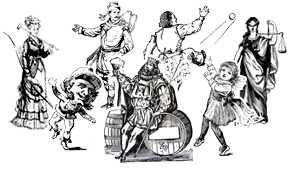Acknowledgements
Wondering where we found our excellent illustrations?
As companies grow and develop, so does their branding. Merge has seen a lot of change over the last year and needed to re-create our brand to reflect those changes in our company's culture and demonstrate our commitment to web excellence. We were first introduced to James Connor’s images by local designer Jennifer Kouyoumjian and were immediately intrigued to see more of his work. His book James Conner's Sons Electrotype Specimens (or as the inside cover awesomely names the book, James Conner's Sons Specimens of Electrotype Cuts, and Corners, Ornaments, and Tints, Etc. Etc. and Etc.) is a collection of 200 graphics ranging from fonts and patterns to animals and people.
Information about James Connor on the web is scarce, so we thought we'd provide a quick history lesson with excerpts from his biography, if you care to learn about this interesting fellow.
James Conner was a pioneer of the typefoundry and electrotyping businesses. After fighting in the war of 1812 at the age of 14, James started his venture into the stereotyping business as an apprentice in New York City. He then removed to Boston where he learned the stereotyping business at the Boston Stereotype Foundry. In 1827 he returned to NYC to start his own business.
James recognized that the counters of many letters from the established type foundries were not cut sufficiently deep enough to allow quality reproductions with stereotyping. Thus, seeking stereotype excellence, he entered the typefounding business.
When the electrodespositing of copper became an economically viable process, it was combined with the stereotype process to produce the electrotype. While James was involved with stereotyping, he had cast the face of large individual letters for posters, and then mounted them on wood bodies. The idea then occurred to him of creating a copper matrix of an individual letter for casting type, and thus the invention of electroplated matrices was accomplished. This meant that type could be cut in lead by an engraver, and then electroplated and reproduced in high quality.
James then recognized the need for illustrations and that the smaller printers were a promising market for some kind of quality-but-inexpensive illustrations. Thus, the "printers cut" was born... a ultimately finely designed and executed wood engraving reproduced in every detail as an electrodeposited copper shell. This made illustrations widely available for small-town printers, and provided visual interest for newspapers, social announcements, and merchandisers that was impossible with type alone.
James Conner was a true businessman and pioneer who continually strived for excellence in his work. We're proud to use his awesome illustrations in our branding to represent our commitment to bringing our clients and viewers web excellence.
